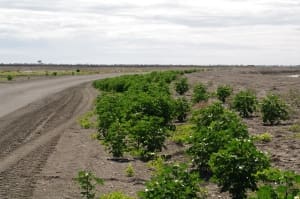RATOON cotton occurs when a plant survives over winter and then regrows from the old root stock. But why is it such a problem?

Ratoon cotton is a host for pests and diseases and poses a risk to resistance strategies. (Photo: myBMP)
For a few reasons. Firstly, ratoon cotton is a host for pests and diseases. Pests such as aphids, silverleaf whitefly and mealybug can use ratoon cotton to survive over winter and re infest the following cotton crop.
Ratoon cotton can also carryover disease such as verticillium wilt, black root rot and fusarium.
Ratoon cotton also poses a resistance risk. The presence of Bt ratoon and volunteer cotton outside of the cotton growing season extends the amount of time Helicoverpa are exposed to the toxins contained in Bt cotton, increasing resistance risk.
In other crops and subsequent cotton crops, ratoon cotton is considered a weed and can affect yield through plant competition.
So how do I control it?
Ratoon cotton is best managed post-harvest. This can be achieved with an effective root cutting and mulching operation after picking. A follow up pupae busting operation or cultivation will further assist with ratoon destruction.
The Bollgard 3 Resistance Management Plan (RMP) says: “as soon as practical after harvest, Bollgard 3 cotton crops must be destroyed by cultivation, root cutting or herbicide so that they do not continue to act as hosts for Helicoverpa”.
The intent of the Bollgard 3 RMP is that following harvest, Bollgard 3 crops are destroyed and prevented from re growing.
Ratoon cotton is very difficult to control with herbicides, especially in other broadleaf crops. Ratoon cotton plants have a very small leaf area compared to a large root system. In practical terms, it is rarely possible to get ratoon plants to take up enough chemical through their leaves to kill the roots. Even above-label rates of herbicide are very unlikely to be effective on ratoon cotton.
Heavy cultivation can be effective in destroying ratoon cotton, however this may not be a preferred option in a dryland system, or if the ratoons are within a rotation crop.
The simplest and most cost-effective way of controlling ratoon cotton? Prevent it from occurring in the first place.
…………….
More information: Read the volunteer and ratoon chapter in the Cotton Pest Management Guide
Contact CottonInfo’s technical specialists for stewardship, Sally Ceeney, and biosecurity and disease, Sharna Holman.
Source: CottonInfo

HAVE YOUR SAY